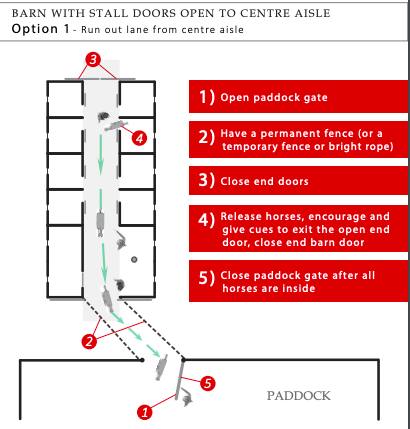Evacuation Infographics added to Equine Guelph Barn Fire Prevention Resources
Equine Guelph has created a set of downloadable infographics to aid in barn evacuation plans, thanks to generous sponsorship by Workplace Safety & Prevention Services. It is well understood that investing in emergency preparedness is the best defense. It can mean the difference between panic or focused execution of a practiced plan during a chaotic situation.
In addition to reviewing the new evacuation infographics Equine Guelph encourages horse care takers to visit our free interactive Barn Fire Prevention tool and check out upcoming online offerings: Fire and Emergency Preparedness short course on TheHorsePortal.ca Mar 8 – 15 and two 90 minute Zoom webinars introducing Large Animal Rescue March 4 and 11
Would you know what to do if you were the person in the barn when a disaster occurred?
Does your barn have a posted and practiced Emergency Action Plan (EAP)?
Are emergency numbers listed? Do you know who to call and the information to give them?
Do you already have a relationship with your fire department, and have they paid a visit to help you identify all the resources and potential hazards on your farm?
What evacuation plan makes the most sense for your facility?

Every facility is different and the new evacuation infographics highlight four possible scenarios and stress the importance of making a plan; including alternate plans and routes – and practice! Your plan should be scalable depending on the number of people on hand to help.
“Every horse owner can do something to make their horse’s space safer. Every horse owner/enthusiast can benefit from the information in this course,” says Fire & Emergency Preparedness student, Cathy Vogelweid, DVM (Columbia, Missouri, USA).
Returning expert guest speaker Rebecca Gimenez-Husted will be available all week during the Mar 8 – 15 Fire and Emergency Preparedness online course. Gimenez has travelled the world providing training in Technical Large Animal Rescue Techniques (TLAER website) and has published numerous critiques, techniques and journal articles on the topic. Rebecca edited the only textbook available to the fire service and veterinarians on technical rescue of large animals. As a volunteer firefighter in Gray, GA, Rebecca is doing R&D work with University of Edinburgh (UK), EKU (KY) and several veterinary schools. A past Logistics Officer for FEMA’s Veterinary Medical Assistance Team (VMAT -2), decorated combat veteran and a Major in the US Army Reserves (retired); Rebecca offers a wealth of information and is active in various organizations related to disaster preparedness.
Victor MacPherson will be presenting material along with Dr. Susan Raymond of Equine Guelph, during the two 90 minute Zoom webinars introducing Large Animal Rescue March 4 and 11. MacPherson became involved with the TLAER program in 2013, having completed several training seminars, and assisted in both training and facilitating courses with Equine Guelph and Dr. Rebecca Gimenez-Husted. During that time Victor was involved with several operational rescues with the fire department. Victor is also a facilitator for fire services response for Farm and Food Care Ontario. Retired from the Adjala-Tosorontio Fire Department where he served for 25 years, 19 years as the District Fire Chief for Station 2. Employed full time with the City of Vaughan Fire as a Master Emergency Vehicle Technician for 19 years, and currently Acting Chief Mechanical Officer. Retired Master Corporal, having served in the Canadian Military attached to armoured units, having served with NATO in Europe.
All large animal incidents regardless of cause or scope, present a risk of injury to responders. To learn more about prevention and what to do in the event of an emergency sign up for: Fire and Emergency Preparednessshort course on TheHorsePortal.ca Mar 8 – 15 and one of the two 90 minute Zoom webinars introducing Large Animal Rescue March 4 and 11

